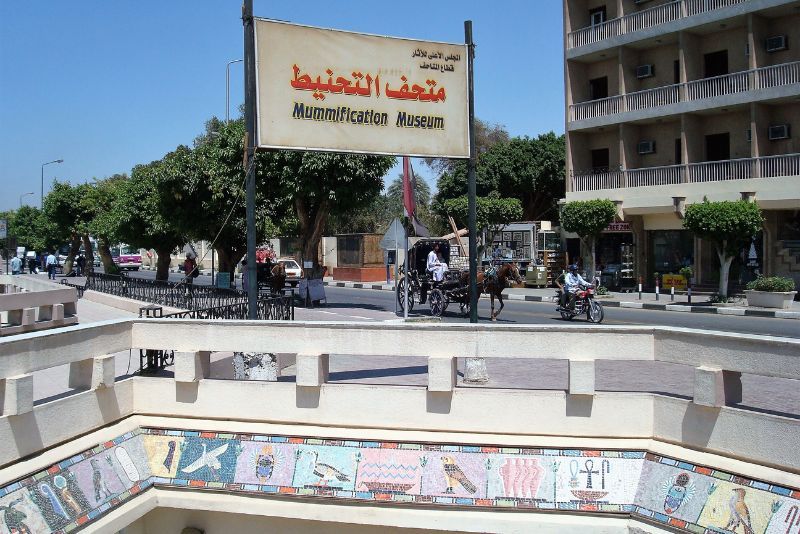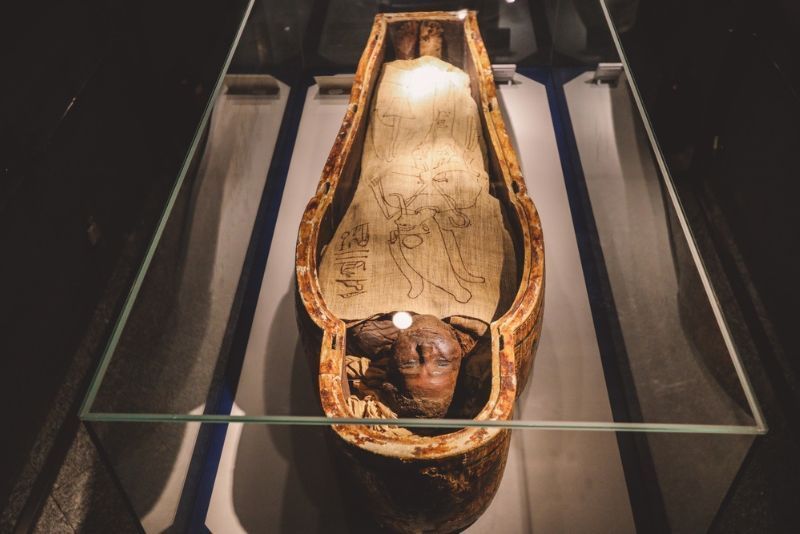Mummification Museum: Tickets and Tours
A little creepy and a lot fascinating, mummies are firmly cemented in legend. Now the stuff of Halloween festivities, mummies have been found all around the world. Egyptian mummies have become the archetypal image of preserved human bodies.
Take a break from touring ruins with a Mummification Museum tour in Luxor. Discover the painstakingly detailed process perfected by ancient Egyptians.
A little creepy and a lot fascinating, mummies are firmly cemented in legend. Now the stuff of Halloween festivities, mummies have been found all around the world. Egyptian mummies have become the archetypal image of preserved human bodies.
Take a break from touring ruins with a Mummification Museum tour in Luxor. Discover the painstakingly detailed process perfected by ancient Egyptians.

(0/24) checking Musement...
A little creepy and a lot fascinating, mummies are firmly cemented in legend. Now the stuff of Halloween festivities, mummies have been found all around the world. Egyptian mummies have become the archetypal image of preserved human bodies.
Take a break from touring ruins with a Mummification Museum tour in Luxor. Discover the painstakingly detailed process perfected by ancient Egyptians.

Here's all you need to know about Mummification Museum, one of the most popular museums in Luxor.
How much do Mummification Museum tickets cost?
Ticket prices to the Mummification Museum depend on your nationality, age and abilities.
- Egyptian/Arab adults: EGP 20 (US$ 0.7)
- Egyptian/Arab students: EGP 5 (US$ 0.2)
- Foreign adults: EGP 100 (US$ 3.25)
- Foreign students: EGP 50 (US$ 1.60)
Is it possible to visit for free?
On all days except Fridays, Saturdays and public holidays, seniors over age 60 and visitors with special needs may enter for free.
Should you book in advance?
Although Luxor’s Mummification Museum is small, it is rarely crowded. Purchasing tickets upon arrival is easy, although you will see larger numbers of visitors on weekends and school holidays.
What are the best Mummification Museum tours?

Mummification Museum tours are a great way to make the most of a visit to two museums in Luxor.
All tours are private, include round-trip transportation from your hotel and also take you to the Luxor Museum. Expert guides enrich your experience with facts beyond the museum displays.
Tours vary in price, from €30 per person to €55 per person. Lower-cost tours tend not to cover museum entrance fees. Guides provide engaging commentary in the museums, but do note that due to religious rules, some guides are not allowed to enter the Mummification Museum.
Mummification Museum and Luxor Museum tours last 4 to 5 hours, with about 1.5 hours in each museum plus a stop at the market if you choose. Since tours are private, you have some flexibility in your schedule.
Neither museum is large, making it easier to delve into the meticulously curated collections. If your tour extends to the market, your guide will help you navigate the stalls and learn the ropes of haggling.
What will you see inside?
Mummies
On display in the museum, you will observe shockingly well-preserved human and animal mummies. Spy remains of a crocodile, fish, cats and a ram. Ponder why ancient Egyptians mummified the parts of a goose and a goat, also on display.
The highlight of the museum is the mummy of Masaharti, so well-preserved that he appears to be sleeping. Masaharti was a general and the son of King Pinedjem I. Inspect the painted surfaces of his coffin.
Discover the meaning of the coffin decorations, why his face was painted in red ocher and the purpose of his gold finger cap.
Embalming tools
Archeologists have unearthed jars and blades that were commonly used to prepare the bodies for burial. See metal tools, unguent jars and coptic jars that contain separately mummified organs.
Not only will you learn about the techniques behind mummification, you will also learn why they were deemed so important.
Offerings
Along with pristine coffins and their colorful, detailed paintings, notice the “ushabtis,” or funerary offerings, that stood watch over the dead. Statues, amulets, figurines and symbols were thought to help usher the dead into the afterworld.
How to get there?
All Mummification Museum tours provide round-trip transportation from hotels or the cruise docks, but there are simple routes to reach the museum. The Mummification Museum is in northern central Luxor on Kornish Al Nile.
There isn’t an official public transit system in town, and driving can be tricky. The best way to get there may be by bike or on foot. It is a little over 2 kilometers from central Luxor
From the hospital zone, take Television north until you reach Salah El Deen. Turn left and continue until you reach Kornish Al Nile. Turn left and continue for 1 kilometer until you reach the museum on your left.
The other destinations of your tour, the Luxor Museum and the market, are within 1 kilometer of the Mummification museum.
What are the opening times?
The Mummification Museum is open daily from 9 AM to 1 PM. There are also evening hours from 5 PM to 8 pm. The ticket window closes at 7:30 PM.
Is it wheelchair friendly?
Yes, both the Mummification Museum and the Luxor Museum are wheelchair friendly. Notify your tour provider of special needs at the time of booking to make sure there is a wheelchair-adapted vehicle available.
When is the best time to visit the Mummification Museum?
Typically, visiting the Mummification Museum during weekdays and outside of major holidays or vacation periods can help you avoid crowds.
When planning your travels to Egypt, it's best to avoid the summer months (May to August) due to the scorching heat, which can make sightseeing challenging. The winter season is the most popular time to visit Egypt, thanks to its cool weather and lower temperatures.
However, keep in mind that this is the peak season, so it's advisable to make proper plans and book in advance.
Travel tips
- The museum may contain displays of mummified remains, which can be sensitive or frightening for younger children. Consider their age and sensitivity to such exhibits before bringing them along.
- Wear comfortable shoes and clothing the museum may require some walking, and you'll want to feel at ease during your visit.
- Plan your visit to make the most of your time there, gather information about the museum's opening hours, admission fees, and any special exhibits or events.
- Pay attention respect the rules and customs, such as dress codes or photography restrictions, to ensure a smooth and respectful visit.

